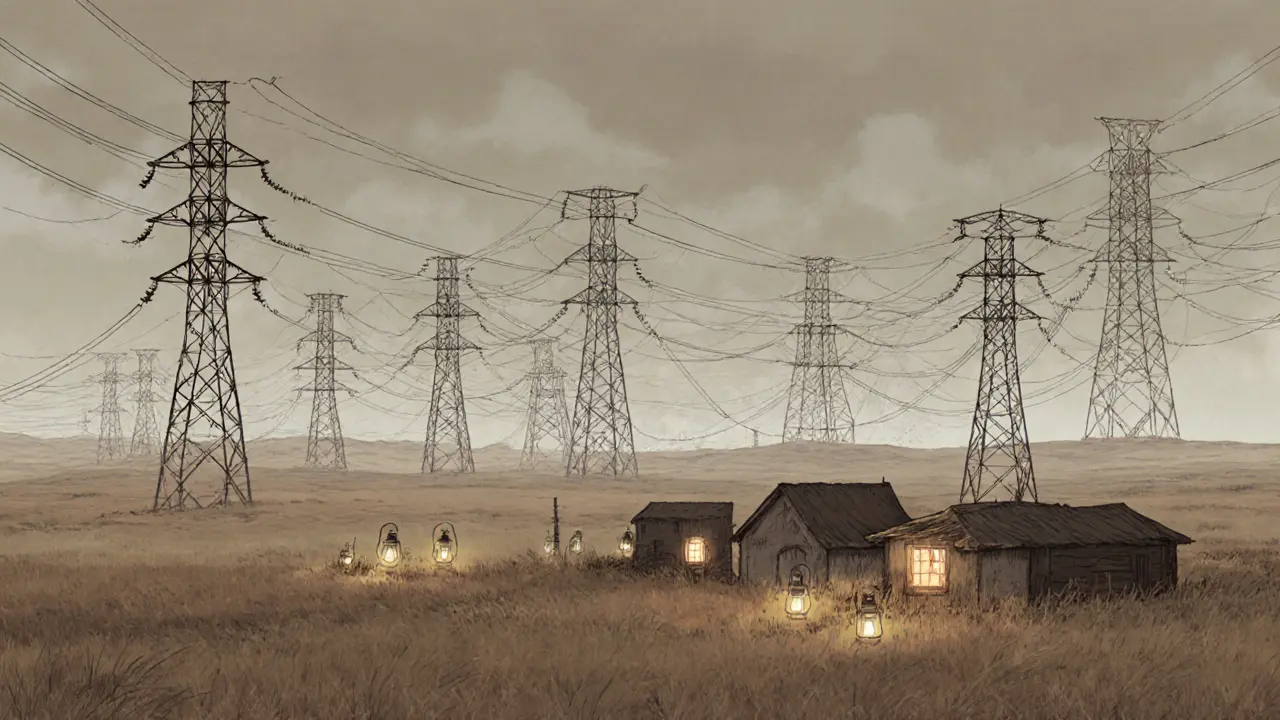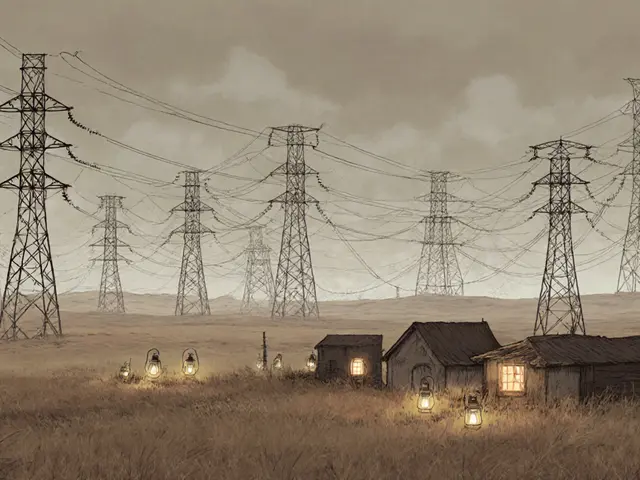Kazakhstan Energy Grid Impact Calculator
Regional Technical Losses
| Region | Technical Loss % | Impact Level |
|---|---|---|
| Oral | 18.00% | High Risk |
| Western Zone (avg) | 13.43% | Moderate Risk |
| National Low-Loss Area | 3.33% | Low Risk |
| National High-Loss Area | 17.44% | High Risk |
Grid Stability Assessment
When you hear about crypto mining getting the boot, you might picture a courtroom drama. In Kazakhstan the story reads more like a blackout thriller - crumbling power lines, soaring transmission losses, and a government scrambling to keep the lights on while trying to curb a booming mining sector.
Why Kazakhstan’s power grid is on the brink
Kazakhstan is a vast, land‑locked nation that relies on a single, nation‑wide transmission system known as the Unified Power System (UPS). The grid is overseen by KEGOC, the state‑owned operator that manages more than 220 power plants, 144 of which are classified as renewable sources.
As of January12024 the total installed capacity stood at 24,641.9MW, but the **available capacity** fell to 20,428.4MW. That gap is not just a number on a spreadsheet - it translates into daily brownouts for factories, schools, and households across the steppe.
How aging infrastructure translates into losses and outages
More than a third of the country’s power plants show 70‑90% wear and tear. In some regional grids the deterioration rate hits a staggering 97%. The technical losses of transmission are equally dramatic. In 2024 the average loss across the worst‑hit zones was 17.42%, meaning roughly one‑fifth of every kilowatt generated never reaches the end user.
Take the city of Oral, where losses once peaked at 18% - every fifth kilowatt simply vanished as heat in overloaded lines. A modest improvement brought the figure down to 13.43% in 2023, yet the region still trails the 10‑12% benchmark common in modern economies.
These losses are not just an efficiency problem; they fuel a cascade of financial strain. The single‑buyer model that dominates Kazakhstan’s market has been forced to raise tariffs by about 50% in April2025 compared with the previous year, squeezing both industrial users and residential customers.

Renewable push and the unfulfilled potential
Renewables currently account for only 6% of total electricity generation, but the government is betting on a rapid transformation. Three gigawatt‑scale wind farms are slated for construction, and the combined solar‑PV and wind output is projected to overtake hydropower by the end of 2024.
Investment pledges exceed $2.6billion, a respectable sum but still half of what neighboring Uzbekistan has attracted for its own green agenda. The bottleneck isn’t funding - it’s a grid that can’t flexibly absorb intermittent power. Outdated transmission lines, weak dispatch capacity, and an under‑developed balancing market keep the system locked into coal‑heavy generation.
The KEGOC Development Plan (2023‑2032) outlines two flagship projects: completion of the Western Zone integration by 2040 and the North‑South HVDC Line (2024‑2029), which will add roughly 2,000MW of transmission capacity. Until those lines are live, renewable growth will continue to be throttled by the fragile backbone.
The hidden strain: crypto mining’s energy appetite
Crypto mining is notoriously power‑hungry. Estimates from global mining surveys place a typical ASIC‑based operation at 0.5‑1kW per megahash. In Kazakhstan, cheap electricity and a permissive regulatory environment made the country a magnet for miners during 2021‑2023, especially for Bitcoin and EthereumClassic.
While official statistics on the sector’s exact consumption are scarce, industry insiders suggest that at peak activity mining farms were drawing up to 3GW - roughly 15% of the nation’s total installed capacity. That figure aligns with the timing of the sharp rise in technical violations: 28,000 cases reported in 2023, many linked to illegal connections and overloads on regional networks.
When the grid started to buckle under load, miners found themselves on the front line of load‑shedding. Rolling blackouts in Almaty and Karaganda during the winter of 2023‑2024 forced many operators to shut down temporarily, leading to a sudden dip in hash‑rate and a brief rally in cryptocurrency prices.
Government response: bans, regulations, and what’s actually happening
The Ministry of Energy, together with the Committee on Regulation of Financial Markets, introduced a set of measures in early 2025 aimed at curbing the mining surge. The core of the policy is a Kazakhstan energy grid ban that prohibits new mining facilities from drawing more than 500MW from the national system without a special permit.
Existing farms were given a 90‑day window to either retrofit with on‑site renewable generation or cap their draw at 200MW. Non‑compliant operators face fines up to 5% of annual revenue and possible disconnection from the grid.
In practice, the rollout has been uneven. Larger miners with deep pockets have applied for “green‑energy licences” by installing solar arrays on desert sites, while smaller outfits lack the capital to meet the threshold and are forced to shut down or relocate to neighboring Russia.
At the same time, the Atameken National Chamber of Entrepreneurs - led by Zhakyp Khairushev - has warned that an outright ban could push illegal mining underground, increasing the risk of unmonitored load spikes and fire hazards.

What the future holds - upgrades, HVDC line, and regional market
Looking ahead, the grid’s fate hinges on two parallel tracks: physical upgrades and market reforms.
- Completion of the North‑South HVDC Line will unlock cross‑border power flows with the CASA‑1000 project, providing a buffer against domestic shortages.
- Smart‑grid technologies, promoted by the Ministry of Energy, aim to cut technical losses from the current 17% down to the global benchmark of 8‑10% by 2030.
- A functional balancing market will allow renewable producers to sell excess power during peak sun or wind, reducing reliance on coal peakers.
On the policy side, the Eurasian Economic Union’s Common Electricity Market, slated for launch in 2025, will introduce price‑matching mechanisms that could soften tariff spikes caused by mining‑related demand spikes.
For crypto operators, the message is clear: adapt or disappear. Those who invest in on‑site renewables or shift to jurisdictions with clearer energy policies will have a competitive edge, while the rest may find themselves out of the mining game.
Practical takeaways for investors and operators
- Monitor grid reliability indexes. Regions like Oral and the South‑East consistently report loss rates above 15%; expect higher operational risk there.
- Factor in the new permit‑threshold when sizing mining farms - staying under 500MW avoids the most stringent licensing.
- Consider pairing mining rigs with solar or wind assets; the government offers tax rebates for “green‑energy mining” projects.
- Watch the HVDC line construction milestones. Once operational, power can be rerouted from lower‑loss zones, stabilizing prices.
- Stay alert to the upcoming Common Electricity Market rules; they may introduce cross‑border arbitrage opportunities for crypto miners.
| Region | Technical Loss % | Notes |
|---|---|---|
| Oral | 18.00 | Highest recorded loss; mining concentration |
| Western Zone (average) | 13.43 | Improved after 2023 upgrades |
| National Low‑Loss Area | 3.33 | Urban centers with newer infrastructure |
| National High‑Loss Area | 17.44 | Rural zones, outdated lines |
Frequently Asked Questions
What triggered Kazakhstan’s crypto mining ban?
A combination of severe grid congestion, rising technical losses, and the government’s push to protect domestic electricity consumers forced regulators to limit new mining projects and cap existing draw‑downs.
How much electricity does crypto mining consume in Kazakhstan?
While exact figures are scarce, industry insiders estimate peak mining demand reached around 3GW, roughly 15% of the country’s total installed capacity, during the 2022‑2023 boom.
Can miners operate legally under the new rules?
Yes, if they stay below the 500MW threshold or obtain a special "green‑energy" permit by installing onsite renewable generation.
What are the main projects aimed at modernizing the grid?
Key initiatives include the North‑South HVDC Line (adding 2,000MW of transmission capacity) and a series of smart‑grid pilots intended to slash technical losses to under 10% by 2030.
Will renewable energy eventually replace coal in Kazakhstan?
Projections show renewable generation overtaking coal by 2025, but the transition depends on grid upgrades and sufficient investment in storage and transmission.







Write a comment
Your email address will be restricted to us